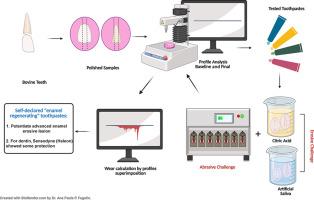Effect of regenerating toothpastes on abrasion of eroded enamel and dentin
引用次数: 0
Abstract
Background
This in vitro study evaluated the effect of self-declared enamel regenerating toothpastes on advanced erosive tooth lesions.
Methods
A total of 48 bovine crown and root samples were allocated into the toothpastes: Elmex Erosion Protection (GABA International AG, 1,400 ppm F; pH, 4.69) (positive control); Dentalclean Regenerator Sensitive (Dentalclean, 1,450 ppm F; pH, 4.97); Sensodyne Repair & Protect (GlaxoSmithKline) (1,426 ppm F; pH, 9.78) and erosion only (no abrasion) (negative control) (n = 12). All samples were subjected to erosive pH cycles (4× 90 seconds/day in 0.1% citric acid, pH 2.5). Groups 1 through 3 underwent abrasive challenges (2× 15 seconds/day abrasion + 45-second treatment) using toothpaste slurries and a brushing machine over 7 days. Between erosive and abrasive challenges, samples were immersed in artificial saliva. Wear was quantified using contact profilometry (in micrometers) to compare the initial and final profiles. Data were statistically compared using analysis of variance and Tukey test (P < .05).
Results
Brushing with Dentalclean (3.67 [0.47] μm) induced the greatest enamel wear (SD), followed by Sensodyne (2.99 [0.56] μm). Both were significantly different (SD) from Elmex (1.85 [0.38] μm) (P < .0001), which did not differ from erosion only (1.98 [0.57] μm). For dentin, brushing with Dentalclean (2.95 [0.60] μm) induced the greatest wear (SD), which was similar to that induced by erosion alone (2.87 [0.55] μm). In contrast, Elmex presented the lowest wear (SD) (1.26 [0.35] μm), similarly to Sensodyne (1.27 [0.58] μm).
Conclusions
Self-declared enamel regenerating toothpastes potentiate advanced erosive lesions. However, for dentin, Sensodyne toothpaste showed a similar result to the positive control.

再生牙膏对侵蚀牙釉质和牙本质磨损的影响
本体外研究评估了自我宣称的牙釉质再生牙膏对晚期侵蚀性牙病变的影响。方法将48份牛冠和牛根样品配制成牙膏:Elmex Erosion Protection (GABA International AG, 1400 ppm F);pH, 4.69)(阳性对照);Dentalclean Regenerator Sensitive (Dentalclean, 1450 ppm F;pH值4.97);Sensodyne修理&;葛兰素史克(GlaxoSmithKline)的Protect (1426 ppm F;pH, 9.78)和仅侵蚀(无磨损)(阴性对照)(n = 12)。所有样品都进行侵蚀pH循环(在0.1%柠檬酸中,pH为2.5,4× 90秒/天)。1 ~ 3组在7天内使用牙膏浆和刷牙机进行磨蚀(2× 15秒/天的磨蚀+ 45秒的处理)。在腐蚀和磨蚀之间,样品浸入人工唾液中。使用接触轮廓法(以微米为单位)对磨损进行量化,以比较初始和最终轮廓。采用方差分析和Tukey检验(P <;. 05)。结果刷牙时牙釉质磨损最大的是Dentalclean (3.67 [0.47] μm),其次是Sensodyne (2.99 [0.56] μm)。两者与Elmex (1.85 [0.38] μm) (P <;0.0001),仅与侵蚀(1.98 [0.57]μm)无差异。对牙本质而言,刷牙时使用Dentalclean (2.95 [0.60] μm)对牙本质的磨损程度最大,与单纯使用牙本质腐蚀(2.87 [0.55]μm)对牙本质的磨损程度相似。相比之下,Elmex具有最低的磨损(SD) (1.26 [0.35] μm),与Sensodyne相似(1.27 [0.58]μm)。结论:自封的牙釉质再生牙膏可增强晚期糜烂损伤。然而,对于牙本质,Sensodyne牙膏显示出与阳性对照相似的结果。
本文章由计算机程序翻译,如有差异,请以英文原文为准。
求助全文
约1分钟内获得全文
求助全文

 求助内容:
求助内容: 应助结果提醒方式:
应助结果提醒方式:


